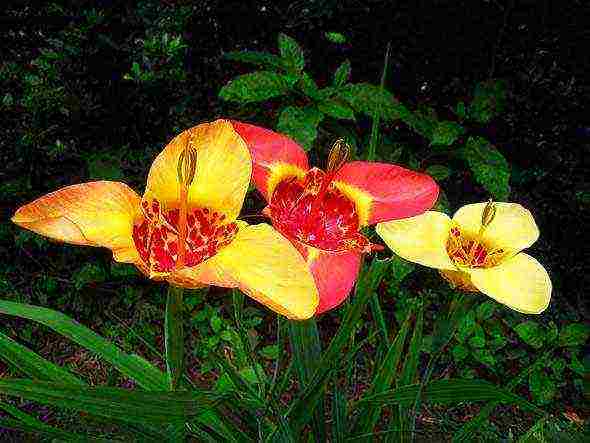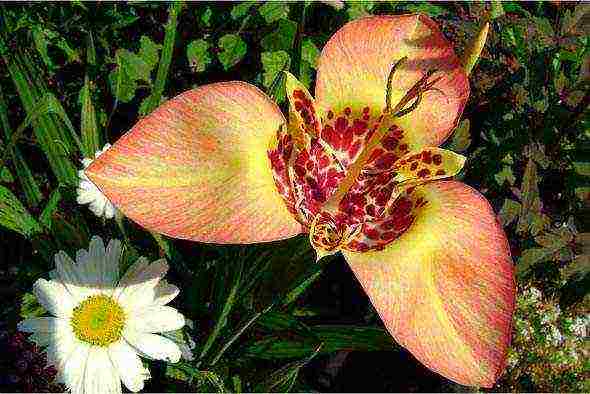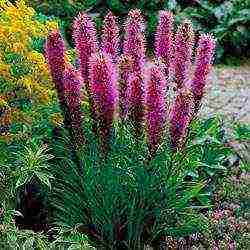Content
- 1 Varieties and types
- 2 Tigridia planting and care in the open field
- 3 Tigrid seedlings
- 4 Watering tigridia
- 5 Fertilizers for tigridia
- 6 Tigridia in winter
- 7 Tigridia growing from seeds
- 8 Diseases and pests
- 9 Features of tigridia
- 10 Planting tigridia in open ground
- 11 Caring for tigridia in the garden
- 12 Tigridia in winter
- 13 Types and varieties of tigridia
- 14 Favorable conditions for planting tigridia
- 15 Tigrid planting methods
- 16 Features of tigridia care
The genus of Tigridia, for different data, belongs to either the Kasatikov family or the Irisov family, but still, most scientists are inclined towards the first option.
This flower is quite exotic and is not yet very often grown, although in general caring for it is not particularly burdensome, and its decorative effect is high.
Varieties and types
The number of the genus is small, and only a few species are grown in culture, the most common of which is Peacock tigridia... This species is native to the central and southern regions of North America.
It is a bulbous perennial that grows up to half a meter or slightly taller. The foliage is xiphoid, folded. From one healthy tuber, up to five flower stems appear on each of which up to five buds can form.
The flower is six-lobed, large, multi-colored - the outer part of the perianth is usually purple with orange or deep red, the inner part is smaller, orange or, more often, spotted. Flowers appear and open in turn and thus flowering lasts almost a month, although the life of one inflorescence is only 9 hours.
The following varieties have been derived from this species:
- Viola - inflorescences are white with red,
- Aurea - yellow carmine petals,
- Canaryensis - the outer part of the flower is soft tones, and the inside is red,
- Lilacia - lilac petals with red and carmine blotches.
Tigridium tubular the shoot of this species is shorter than that of the Peacock, moreover, it branches well. The foliage is also smaller. Flowers of a delicate pink shade.
Tigridia Chess the name of the species speaks for itself - on the petals of this species, the spots are staggered.
to the table of contents
Tigridia planting and care in the open field
Caring for tigridia is not particularly burdensome, but still the flower is quite exotic and its cultivation has its own nuances. The site for planting should be selected well-lit, not blown by drafts.
When grown in warm regions where early planting can be done, the shoots of the plants will be stronger and can be done without supports, provided there is enough sun and no wind blowing.
Soils are preferably light, loose, nutritious, with drainage, the reaction is neutral, acidic soils are not welcome. If the substrate is too heavy, for example, clay, then it is mixed with sand, pebbles. Otherwise, caring for the plant is similar to caring for gladioli.
In warmer parts of the mainland, for example, in Ukraine, southern Russia and Belarus, planting can be carried out in the soil in late spring. The bulbs are completely deepened into the ground, and at least 15 cm is left between the individuals.After a month or a little more, sprouts will begin to hatch. The bushes grow large, but they will begin to bloom only at the end of summer.
If you are interested in how gladioli are grown when planting and nursing in the open field, as well as many other recommendations for keeping this plant, read this article.
to the table of contents
Tigrid seedlings
It is worth noting that when planting directly into the soil in late spring, new bulbs do not develop very well, so even when living in warm regions, it may be advisable to plant in pots in advance.
In more northern regions, located at the level of St. Petersburg, it is better to plant early (in early spring) in pots and grow them before summer in greenhouses.
As a rule, tigridia bulbs are placed in pots in a mixture of peat, sand and turf, 3 pieces each. They are watered a little, and when the sprouts hatch, watering is intensified. Before being transplanted to a flower bed, they are grown in normal room conditions. If you do not carry out such growing, then the shoots may begin to stretch up unnecessarily and they will have to be tied to supports.
At the beginning of summer, they are transplanted into open soil, often done together with a pot. It is advisable, before the procedure, to put 30 cm of horse manure mixed with foliage into the holes, and up the same amount of soil, and then lower the pot with the plant.
to the table of contents
Watering tigridia
Watering is carried out as the soil dries up; in the heat, the amount of liquid is increased. Water for irrigation should be warm and, preferably, deep watering.
That is, dig in a piece of a tube with holes next to the plant and pour water into it. Strong watering is needed during flowering.
to the table of contents
Fertilizers for tigridia
After planting, it is advisable to apply nitrogen fertilization at the rate of 35 g per 1 m2. A month after planting, a complete liquid mineral fertilizer is applied, the dose indicated on the package.
During budding, it is not bad to add nitrophosphate - 50 g per 10 liters of water for irrigation. Leaves can be sprayed with the same solution.
to the table of contents
Tigridia in winter
With the withering of the flowers, the shoot is cut off. This is necessary so that the bulbs are better prepared for the subsequent wintering. If the stems are too tall or topple over, be sure to make supports for them.
After the first light frost, the green part of the bushes will die, after which it is cut off, and the bulbs are dug out, carefully cleaning off part of the earth, but part is left - it will fall off later.
They are dried in the room for at least 30 days. 10-15 days after you start to dry the material, the remnants of the earth are cleaned off from it, the roots are cut off, and the hemp is cut to 2 cm.
For dry storage, it is best to use sand. If the storage place is too damp, then it is better to simply hang the material in a nylon mesh.
In the spring, before planting, the tubers are separated. They do this 4 days before planting, because the places where the bulbs were pressed one to one should dry out.
to the table of contents
Tigridia growing from seeds
In southern latitudes, where flowering begins in mid-summer, tigrid seeds can be collected and the plant propagated with them.
Sowing is carried out in the middle of winter, preliminary stratification, that is, treatment with low temperatures, is not required. Sowing is carried out in a mixture of sand and peat in a ratio of 1 to 1.
The substrate is not allowed to dry out, periodically watering it easily. Seedlings begin to hatch 10-20 days after sowing.
At the end of spring, seedlings can be planted in a flower bed, and by autumn the bulbs obtained from young plants will already be suitable for further reproduction.
How to collect, store the bulbs and plant them, that is, about the vegetative method of reproduction, was mentioned above.
to the table of contents
Diseases and pests
When growing tigridia, you can face various problems. Most often, gardeners have to deal with rotten bulbs in winter... In order for the planting material to be better stored, it is treated with fungicidal preparations, for example, a weak solution of foundationol.
Occasionally occurs rust damage... Wherein red spots appear on the foliage... To combat this fungus, sore spots are cut off and a 1% solution of Bordeaux liquid or similar fungicides is used.
Lack of flowering It often happens when fertilizers with a high nitrogen content are applied on nutrient soils, while the foliage begins to grow strongly, and, on the contrary, does not bloom.
Tigridia bulbs love to eat bear... By affecting the root system of the plant, they destroy it. This pest can be detected by small piles of earth on the surface of the soil. It is best to deal with them with traps with dung, honey or beer. Also, having found a nest, you can fill it with soap and water. If there are too many pests, then they resort to chemicals.
Thrips feed on plant juices. This pest reproduces extremely quickly in warm weather, and in addition, it can affect many different plants. He leaves behind him yellow dry spots on foliagethat soon dies and dries up.
Due to thrips, flowering ends early. They fight this insect by spreading sticky paper around the plants and using infusions of tobacco, celandine, insecticides.
Sometimes tigridia is attacked slugs... To combat them, it is enough to scatter lime or crushed eggshell around the plants. Also, these pests can be harvested by hand.
to the table of contents
A bulbous herbaceous perennial plant, Tigridia, is a member of the Iris family. According to various sources, this genus unites 20–55 species. The range of this culture extends from Mexico in the north to Peru and Chile in the south. The name of this flower is derived from the Latin word tigris (in the genitive case - tigridis), which means "tiger", most likely, this is due to the variegated color of the perianths. Previously, the Aztecs lived in Mexico, they grew these flowers, because they have medicinal properties. In Europe, tigridia has been cultivated since the 16th century, but it has never been very popular with gardeners, most likely, this is due to the fact that such a plant blooms only in the first half of the day, and the life span of a flower is only 8 hours.
Features of tigridia
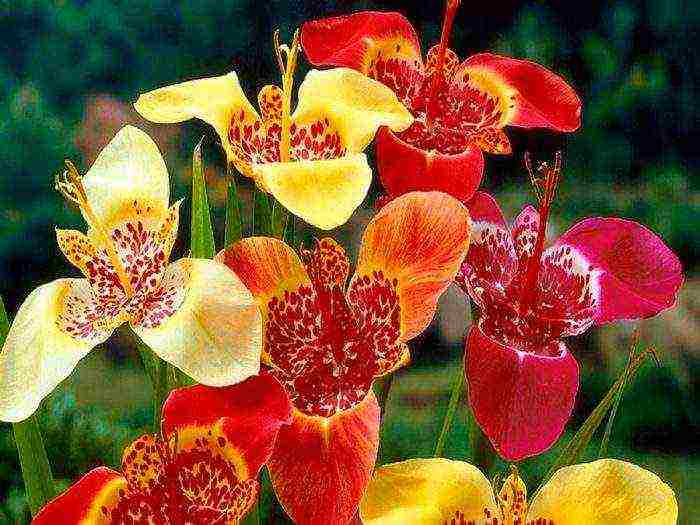
The height of the tigridia bush can vary from 0.3 to 0.7 m. This perennial bulbous plant can have branched or simple shoots. Evenly folded greenish leaf plates have a xiphoid shape. At the tops of the arrows there are single flowers, and they can also be collected in 2 or 3 pieces. The flowers have a bizarre shape, similar to an exotic butterfly. The fruit is a capsule with squeezed, angular seeds inside.
Planting tigridia in open ground
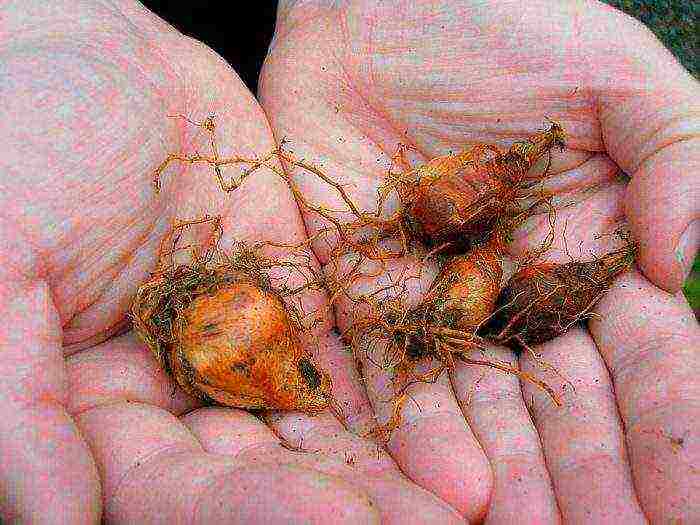
What time to plant
Since tigridia bulbs react extremely negatively to frosts, they should be planted in open soil only after warm weather has established, as a rule, this time falls on the last weeks of spring or the first - summer. For planting, choose a sunny, open area. It is possible to grow this culture in partial shade, however, in this case, the peduncles will become weak and thin, and therefore they will need a garter to the support. Also, the site must be protected from drafts and sudden gusts of wind, as they can injure the thin and weak shoots of this flower. A suitable substrate should be loose, light, moderately moist, well-drained and non-acidic. To fix excessively dense soil, you can add sawdust or sand to it.
Landing rules
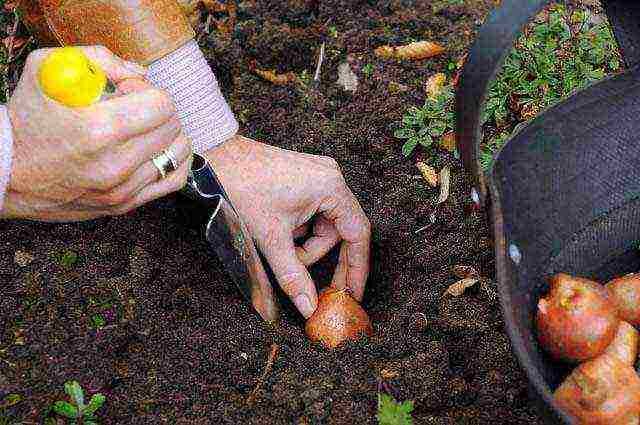
Immediately before planting, the planting material should be immersed in the Maxim solution for a couple of hours (for 1 liter of water, 2 milligrams). The bulbs treated in this way will be protected from fusarium, white and gray rot and other diseases. To what depth to plant the bulbs directly depends on their size. For example, the smallest bulbs should be planted to a depth of about 50 mm, and the largest ones are buried in the soil by 100 mm.A distance of at least 15 centimeters should be maintained between the bulbs in a row, while the distance between the rows should be about 20 centimeters. The first shoots can be seen only after 30–40 days, the grown bushes will bloom in August, but as a rule, they do not have time to bloom before frost, which is extremely bad for replacing bulbs. In this regard, experienced gardeners advise, before planting corms in open soil, to grow them indoors. To do this, in the last days of March, they are placed for distillation. More about this will be discussed in the section on transplanting this plant.
Caring for tigridia in the garden
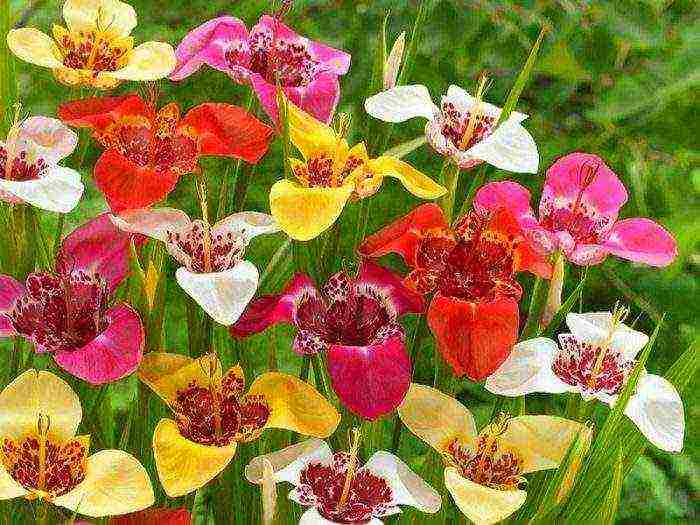
Growing a tigridia in your garden is quite simple. She needs to ensure timely watering, weeding, feeding and loosening the soil surface between the bushes. Experienced gardeners advise to cover the surface of the site with a layer of mulch, this will not only preserve the structure of the soil, but also reduce the number of watering, weeding and loosening. It will also be necessary to remove flowers that have begun to fade in time, and, if necessary, tie bushes to pegs or twigs.
How to water and feed
When grown in a garden, this plant needs systematic watering. During a prolonged drought, the bushes should be watered every day, while using such a volume of water so that the ground can get wet to the depth of the corms. Also, with prolonged drought, the aerial part of the bushes will need to be moistened from a spray bottle with lukewarm water in the evening.
If, in preparation for planting, all the necessary fertilizers were introduced into the ground, then it will be possible to forget about feeding the tigridia until the end of the season. If the soil is poor or depleted, then the bushes will need to be fed only a couple of times per season, and a solution of complex fertilizer is used for this (3 grams per 1 liter of water). Top dressing should be applied 4 weeks after the appearance of foliage and during budding.
Transfer

In order for the plants to bloom early, at the beginning of the spring period, the bulbs need to be grown indoors. They should be planted in the last days of March in a pot of light soil. 3 or 4 corms are planted in 1 pot at once, while they must be buried into the substrate by at least 30 mm. Bulbs will need to be watered moderately in the first weeks. After the corms begin to sprout, the abundance of watering must be increased, it should be taken into account that the substrate should get wet to the depth at which the roots of the corms are. It is best to choose pots with wide openings for drainage for planting corms, and the plate stand should be quite high so that the tigridia can be used for bottom watering. With such watering, the risk of developing fungal diseases is relatively lower. After the arrows appear, the containers with tubers must be transferred to a well-lit warm windowsill. Remember that drafts are contraindicated for these plants. These corms are planted in open soil in the first days of June.
The depth of the planting pit for the transplanted plant should be from 0.5 to 0.6 m.At the bottom of the pit, a drainage layer should be made of horse manure or broken brick, while its thickness should be from 0.2 to 0.25 m. it should be laid with a layer of loose soil of the same thickness as the previous one. Then it is necessary to place a sprouted corm on it, after which the hole is covered with nutritious soil. Transplanted plants need abundant watering.
Reproduction of tigridia
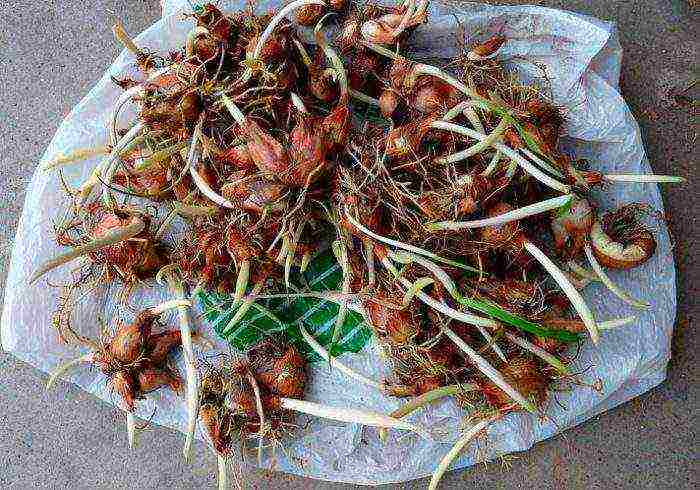
In the event that the bushes begin to bloom from mid to late July, then the seeds will be able to ripen before frost. Seeds are harvested before frost begins. Their sowing is carried out in the winter, while pre-sowing preparation is not needed for the seeds. The containers are removed in a well-lit, warm (from 20 to 25 degrees) place.When diving seedlings, you need to be very careful to avoid injury to their roots. After the seedlings develop a pair of true leaf plates, they should be cut into individual pots, while they are taken along with a lump of earth. From the moment of sowing to the beginning of flowering, it takes about 6-7 months.
Also, vegetative methods can be used to propagate this culture. During 1 season, about five replacement children grow in one adult corm. They should be separated from the parent bulb before planting, while the places of breaks and cuts should be sprinkled with coal powder, after which the children can be planted in the soil.
Diseases and pests
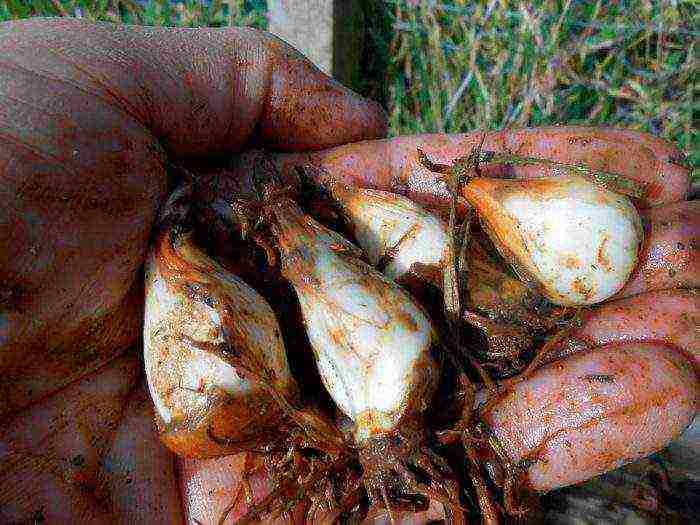
Quite often, gardeners are unable to preserve tigridia planting material until spring, because most of it rots. As a rule, rot appears on those bulbs that are poorly ripe. That is why it is extremely important, before starting the preparation of corms, to make sure that they are well ripened. Also, for prevention purposes, it is imperative to poison the corms before storing them in any fungicidal solution, for example: Maxim, Benlate or Fundazole.
A plant grown outdoors can be affected by scab or rust. To prevent this, it is recommended to spray the foliage with plant infusions or fungicide solutions.
If the plant is affected by the mosaic, then it is no longer possible to cure it, since viral diseases are currently considered incurable. In this regard, it is extremely important to provide the plant with proper care and conditions suitable for growth so that it is strong and less painful.
Bears, slugs, cabbage scoops and thrips are capable of harming tigridia. To exterminate thrips, as well as the scoop, along with their caterpillars, the foliage of the bushes must be sprayed with a solution of any insecticide. Slugs are collected by hand in order to facilitate their work, pieces of slate or boards are laid out on the site, under which most of the gastropods slide down during the hot time of the day. Remove them from under the bait and destroy. And it is necessary to pour the soap solution into the discovered moves of the bear. If the bear tries to escape by getting out, it should be caught and destroyed.
Tigridia in winter

Storage preparation
Since tigridia is a thermophilic plant, it is possible to leave it for the winter in the open ground only in the warmest southern regions. Therefore, with the onset of autumn, most gardeners remove the corms from the soil and store them until spring, while choosing a cool enough place, but the temperature there should not drop below 0 degrees. However, digging up tigridia corms and storing them is not so simple. In order for the planting material to be well preserved until spring, it must be fully ripe, and for this you need to know exactly when to remove the bulbs from the soil in the fall. This procedure is carried out only after all the leaf plates on the bush wither. If there is a threat of frost, but the foliage is still green, it is recommended to dig the bushes together with a lump of earth, which must be large enough, then it is transferred to a cool and well-lit room. Only after the leaf plates turn yellow and wither, it will be possible to start harvesting the planting material for storage. Preparation of corms for storage includes their cleaning, rinsing, as well as etching in a solution of the Maxim preparation and thorough drying. Separation of children from parental bulbs should be done in the spring before planting, but not in the fall.
Storage rules

Corms should be placed in a container filled with dry sand or peat. They are stored for storage in a cool (3-10 degrees) room with normal air humidity.Also, the bulbs, if desired, can be folded into paper bags, which are removed on a refrigerator shelf intended for vegetables, where they will be stored until spring. During the winter, do not forget about the bulbs; a systematic check should be made, during which all spoiled and rotten bulbs must be discarded.
Types and varieties of tigridia
 Peacock tigridia
Peacock tigridia
Gardeners cultivate only 1 type of this culture - peacock tigrid (Tigridia pavonia). This species is native to Mexico and Guatemala. The height of the bush can vary from 0.25 to 0.7 m. On the surface of the corms, which have an irregular shape, there are membranous scales. The bulbs are 60 mm long and about 40 mm in diameter. At the end of the growing season, there is a complete depletion of the old corms, but children grow up in it, which form nests. In the parent corm, the number of children and scales on the surface is almost the same. From one bulb, 3-5 peduncles will grow, and about 5 flowers are formed on each of them. Greenish wide leaf plates folded along the length have a xiphoid shape. The flowers, reaching 10-15 centimeters across, consist of 6 lobes that open alternately. In the perianth, the outer lobes are colored orange-violet or deep red, and the inner ones are not as large as the outer ones, they have an orange-yellow spotted color, like the pharynx. Tigridia blooms in July – August, with the life span of each flower being 8–10 hours. In general, the duration of flowering is about 2–3.5 weeks. Garden forms:
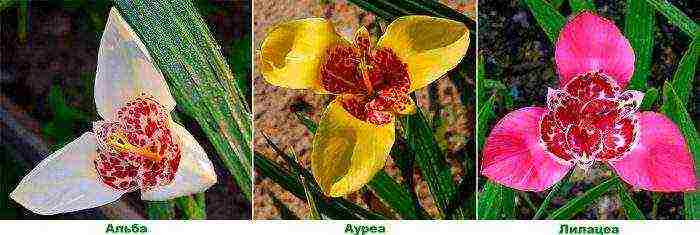
- Alba... The flowers are white, and there are red spots on their surface.
- Aurea... There are carmine spots on the surface of the dark yellow flowers.
- Carminea... The flowers are orange, covered with yellow spots.
- Lilacea... Carmine specks are located on red-purple flowers.
- Rosalind... The color of the flowers is pale pink.
- Canaryensis... The yellowish flowers have a rich red center.
- Speciosa... The color of the flowers is scarlet-red, and they have yellow-golden spots on them.
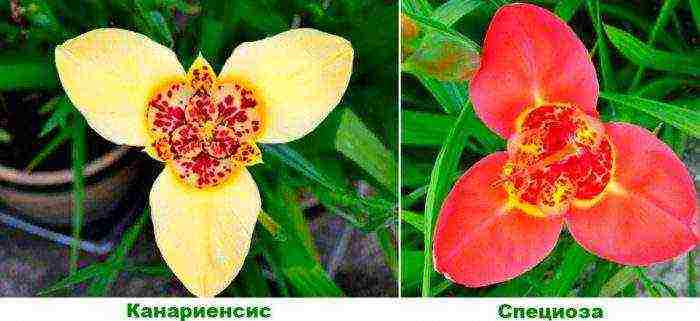
The variety mixture "Tigridia Ferraria mixed" is quite popular: the height of the bush is about 0.6 m, the leaf plates have a xiphoid shape, the flowers reach 15 centimeters in diameter, their outer petals are monochromatic (lilac-pink, white, red, orange or yellow) , there are spectacular specks on the three inner petals. Specialists engaged in breeding use in their work Mexican tigridia with yellow flowers, tubular tigridia with pinkish flowers and tigridia selerianu - lilac-blue flowers. And they also use other types that are not independently grown by gardeners.
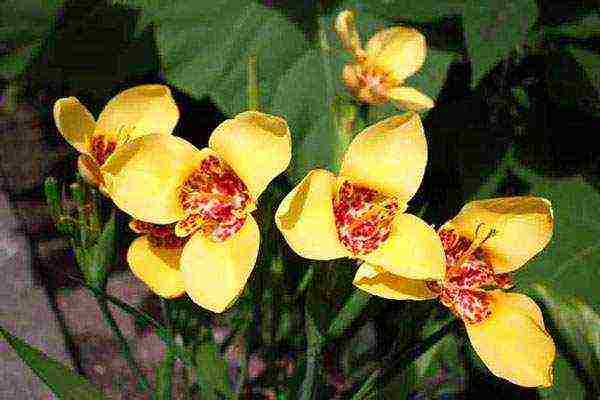 Tigridia is a plant of the Iris family, brought to our latitudes from South and Central America. Despite the fact that the tigridia is a thermophilic flower, planting and care in the open field is also possible in central Russia. It is enough to choose the right place for planting and take good care of the plant during its development.
Tigridia is a plant of the Iris family, brought to our latitudes from South and Central America. Despite the fact that the tigridia is a thermophilic flower, planting and care in the open field is also possible in central Russia. It is enough to choose the right place for planting and take good care of the plant during its development.
Favorable conditions for planting tigridia
 Since tigridia belongs to the thermophilic bulbous flowers, the best place to plant it will be a site protected from strong winds on the sunny side. It is possible to plant tigridia in open ground in the Moscow region in partial shade conditions. The brightness of color and splendor of flowering will practically not suffer from this, but it is advisable to tie pegs to each stem - the stems become thinner from lack of sunlight and may not withstand the severity of the buds.
Since tigridia belongs to the thermophilic bulbous flowers, the best place to plant it will be a site protected from strong winds on the sunny side. It is possible to plant tigridia in open ground in the Moscow region in partial shade conditions. The brightness of color and splendor of flowering will practically not suffer from this, but it is advisable to tie pegs to each stem - the stems become thinner from lack of sunlight and may not withstand the severity of the buds.
Some growers tie tigridia to pegs so that the stems do not break from gusts of wind.
 Loamy or sandy soil is suitable. It is important that it is not too hard, otherwise the tender bulbs simply will not be able to develop.Therefore, before planting, you can add sawdust to the soil and loosen it thoroughly. Fertilizers mixed with sand for better moisture conductivity will not interfere. Otherwise, if the liquid stagnates in the soil, rotting of the bulbs may begin.
Loamy or sandy soil is suitable. It is important that it is not too hard, otherwise the tender bulbs simply will not be able to develop.Therefore, before planting, you can add sawdust to the soil and loosen it thoroughly. Fertilizers mixed with sand for better moisture conductivity will not interfere. Otherwise, if the liquid stagnates in the soil, rotting of the bulbs may begin.
Tigridia prefers a neutral soil composition, so if the soil in your area is acidic, treat it with a lime mortar.
Tigrid planting methods
Planting and caring for tigridia outdoors begins with choosing a growing method.
Planting seeds
 It is advisable to sow the seeds of tigridia already in winter, in pots or boxes, so that after the frosts have passed, the bulbs can be planted in the open ground. In this case, by the fall, the bulbs will have time to get stronger - next year you can already expect the appearance of blossoming buds.
It is advisable to sow the seeds of tigridia already in winter, in pots or boxes, so that after the frosts have passed, the bulbs can be planted in the open ground. In this case, by the fall, the bulbs will have time to get stronger - next year you can already expect the appearance of blossoming buds.
 Sandy soil is suitable for seedlings, you can add a little peat. The sowing depth is small - about 3 millimeters. Each plant should be at least 5 centimeters apart so that later they do not have to be repotted several times.
Sandy soil is suitable for seedlings, you can add a little peat. The sowing depth is small - about 3 millimeters. Each plant should be at least 5 centimeters apart so that later they do not have to be repotted several times.
For the first time, abundant watering of the seeds is necessary, but moderate moisture is more suitable for adult bulbs.
Seeds sprout quickly - with proper care, the first shoots will appear in 2-3 weeks. You can divide the sprouts into separate containers, or you can leave them together, provided that the plants are sufficiently separated from each other, as in the photo. Planting tigridia in open ground is carried out by the end of May.
Using bulbs for planting
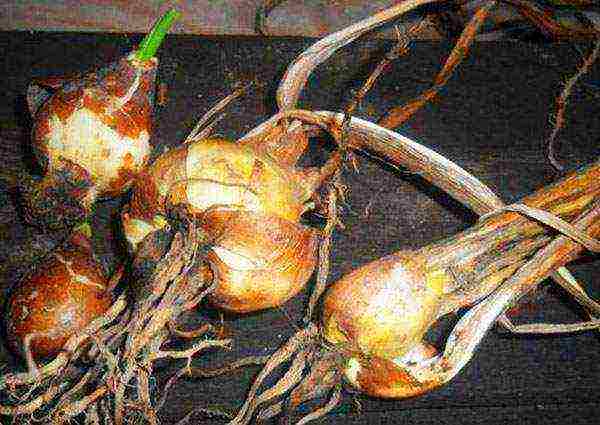 Planting and caring for tigridia outdoors in spring is best done with already sprouted bulbs. The seeds may not ripen before the onset of the autumn cold, and the entire flower bed will simply die with the onset of the first frost.
Planting and caring for tigridia outdoors in spring is best done with already sprouted bulbs. The seeds may not ripen before the onset of the autumn cold, and the entire flower bed will simply die with the onset of the first frost.
Large bulbs are planted to a depth of 10 cm, small ones - 5 cm. The distance between individual plants should be at least 15 cm - tigridia blooms magnificently only when it is given great freedom.
Features of tigridia care
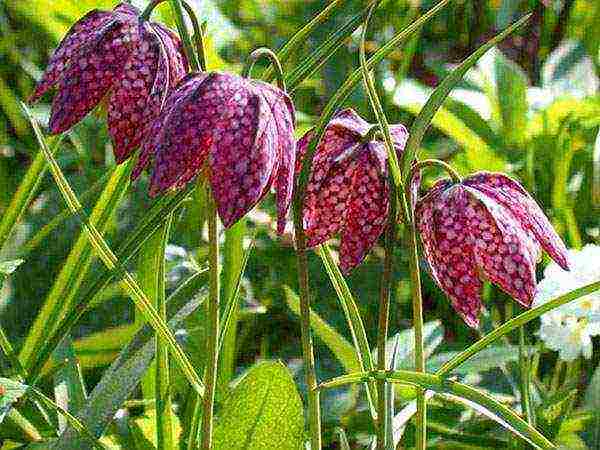 After the tigridia has been planted, caring for it in the open field is not difficult, it is enough to follow some rules for watering and fertilizing.
After the tigridia has been planted, caring for it in the open field is not difficult, it is enough to follow some rules for watering and fertilizing.
In hot weather, you need to make sure that the soil near the bulbs does not dry out. However, surface watering will not work - it will only harm the flowers. Therefore, before watering the tigridia, carefully loosen the soil so that the liquid reaches the bulbs and moistens them properly.
If the summer is without rains, the aerial part of the flower may also suffer from drought. In this case, the leaves and buds are additionally sprayed with water, but not in the middle of the day, but in the evening or in the morning.
After the tigridia has faded, and its aerial part has completely faded, the dried leaves and stems are removed and watering is no longer carried out.
If the soil was well fertilized before planting, then the plants do not need additional feeding. But on depleted land, it is better to make two dressings so that the tigridia will release lush and bright buds. Specially selected mineral complexes can be used as fertilizer. The first time they feed the soil after the leaves have appeared on the plants. The second is before the buds begin to bloom.
Let's summarize:
- It is best to plant tigridia on the sunny side of the site, where there are no strong winds.
- Soil - sandy or loamy, neutral reaction. You can add peat.
- When to plant tigridia outdoors? The bulbs are planted after the last spring frosts have passed, and seeds begin to germinate in the winter, in pots.
- Watering is sufficient to keep the bulbs hydrated without starting to rot. The soil should be loosened before watering.
Tigridia video
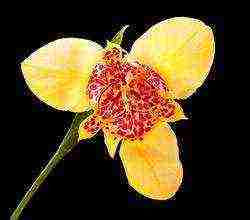 Tigridia began to appear in our flower beds relatively recently, despite the fact that Europe fell in love with this flower more than five centuries ago. Even 20 years ago, in the photo, this plant was mistaken for a strangely shaped tulip.Tigridia, planting and caring for which is not so much trouble, is increasingly found in flower beds and flower beds. Growing it outdoors, simplicity of reproduction, variety of varieties, cannot but make it a welcome guest in any garden.
Tigridia began to appear in our flower beds relatively recently, despite the fact that Europe fell in love with this flower more than five centuries ago. Even 20 years ago, in the photo, this plant was mistaken for a strangely shaped tulip.Tigridia, planting and caring for which is not so much trouble, is increasingly found in flower beds and flower beds. Growing it outdoors, simplicity of reproduction, variety of varieties, cannot but make it a welcome guest in any garden.
Description: varieties and varieties of tigridia
This flower owes its name to its unusual coloring; the spotted pharynx of the plant resembles the color of a tiger. The Aztecs also ate baked tigridia tubers. They were believed to cure stomach ailments, fever and infertility.
There are about 20 varieties of this plant, but in horticulture it is represented by a more modest assortment.
- Tigridia Alba. Flowers of this variety are about 15 cm in size, white with a variegated middle.
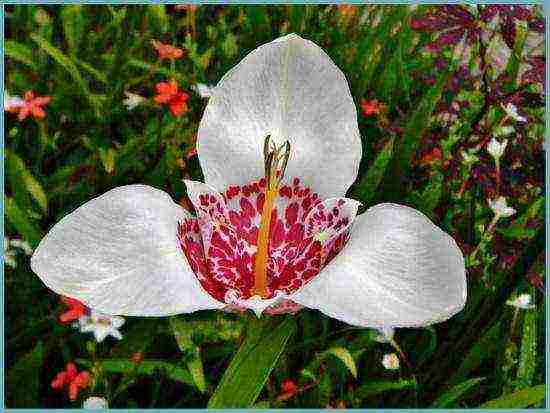
Tigridia Alba
- Tigridia Canaryensis. Inflorescences of pastel colors with a bright red center reach 10-15 cm.

Tigridia Canaryensis
- Tigridia Auer. Bright yellow inflorescences with a variegated middle up to 15 cm in size.
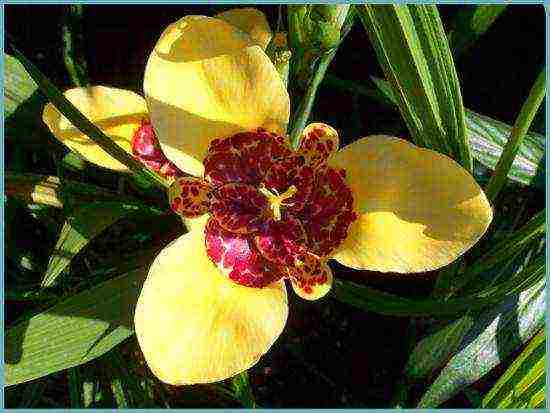
Tigridia Auer
- Tigridia lilacea. The inflorescences exceed 10 cm and have a bright pink tint around the traditionally variegated center.

Tigridia lilacea
The photo on the package with seeds will help you to choose your variety of tigridia.
Planting a plant
Tigridia is a rather powerful plant, therefore it needs fertile, moderately moist, loose soil.
It takes root well on loamy and sandy soils. To plant tigridia, choose a sunny spot in your area.
Advice. A flower garden with tigridia should be protected from the wind.
Thin stalks of tigridia can break under gusts of wind, therefore some gardeners strengthen them by tying them to pegs.
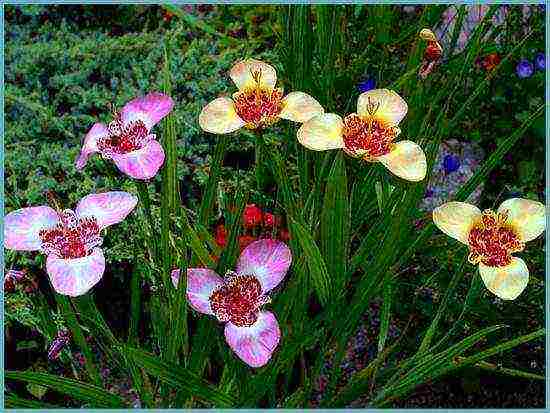
Tigridia should be planted in a place protected from the wind.
Tigridia blooms from July to September, but the flower blooms for only 8-10 hours, after which, unfortunately, it fades. However, planting tigridia in groups allows you to create the effect of continuous flowering, because each bulb produces 3-5 stems, each of which forms up to 5 buds. Their alternate flowering creates a never-ending riot of colors in your garden.
Growing tigridia by seeds
Tigridia seeds have excellent germination, so they are often planted in open ground in this way. The main thing is to choose the right time. If the seeds are sown in late spring, the bulbs may not mature well until fall. Therefore, the seeds are planted in late March - early April in the soil, into which you need to add a little sand and peat.
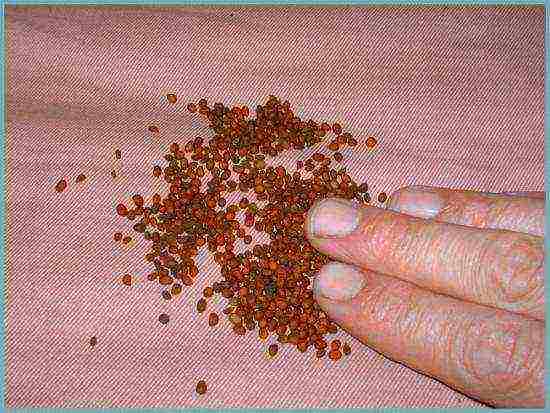
Tigridia seeds
Seeds are planted to a depth of 2-3 mm, no more. They try to place each plant individually in order to facilitate later planting in open ground. Tigridia sprouts will appear in three weeks. If they are planted in a common container, then after a month the plant is divided into hotel pots. Directly in the open ground, tigridia are planted when the danger of frost has already completely passed.
Plant care
Caring for tigridia is very simple. It is not necessary to loosen the soil, it is enough to cover the soil surface with a layer of peat or humus, and under this fur coat the earth will remain porous and will not be compacted.

Tigridia takes very well spraying with clean water on foliage
Watering is a very important part of caring for these plants. Simple irrigation of the soil is not enough, the soil needs to be completely saturated. The regularity of watering should be calculated based on the frequency of rainfall. If the summer is dry, then you need to water not only daily, but also irrigate the upper part of the plants.
Fertilization and feeding
After planting, tigridia needs nitrogen fertilization. It should be made in the amount of 30-40 g per 1 sq. m. At the beginning of flowering, the plant is fed with nitrophos in the same amount. Some flower growers recommend completely fertilizing tigridia once every two to three weeks with complex fertilizer, which is applied at the root along with watering.
Reproduction of tigridia
Tigridia are propagated by bulbs. Up to seven babies appear in one tuber per season.In the fall, the bulbs are dug up, dried for three to four weeks and stored in the basement in boxes with sand or peat, or in the refrigerator, previously wrapped in paper bags.
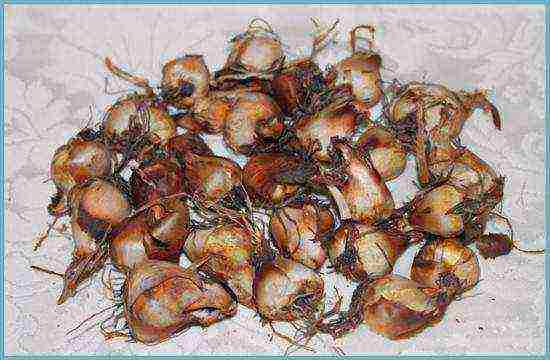
Tigridia bulbs
Attention. Tigridia bulbs are very sensitive, rot can form in places of mechanical damage, which will lead to the death of the flower. Be careful when storing and digging out the bulbs.
In spring, the bulbs are checked for rot and mold, and good bulbs are planted in the garden. In cold regions, it is preferable to plant the bulbs in the spring first in pots or boxes on the veranda, or any other room with sufficient sunlight, and tigridia should be planted in open ground only when the threat of return frosts has finally passed.
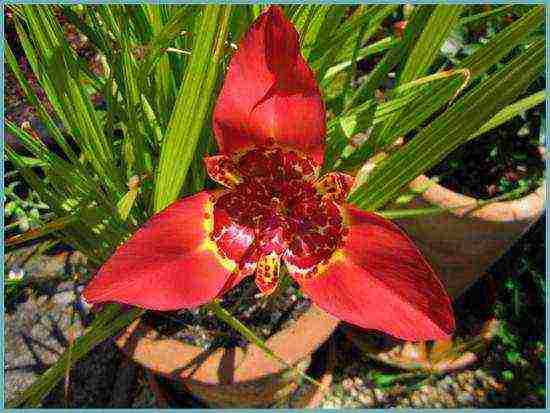
Do not plant the bulbs too close to each other - follow the planting pattern
Some gardeners recommend making a warm bedding for better flowering. To do this, a pit is dug for a planting 50–60 cm deep, and a broken brick is placed on the bottom of the pit for drainage. From above, horse manure is poured onto the drainage in a layer of up to 25 cm, and the last layer is poured into loose earth. In such a bed, seedlings will take root more easily, they will grow better and will bloom earlier.
Advice. When the plant has faded, remove the seed box so as not to weaken the flower.
When the plant has faded, it is necessary to dig out new corms. In autumn, the old onion usually dies off completely, and 5-7 new ones appear in its place. They must be stored until spring.
Diseases and pests
The most dangerous pest of tigridium is the cabbage scoop. But they are not insured against damage by bears, thrips and slugs. To combat these pests, they use proven drugs that can be found in any gardening store.
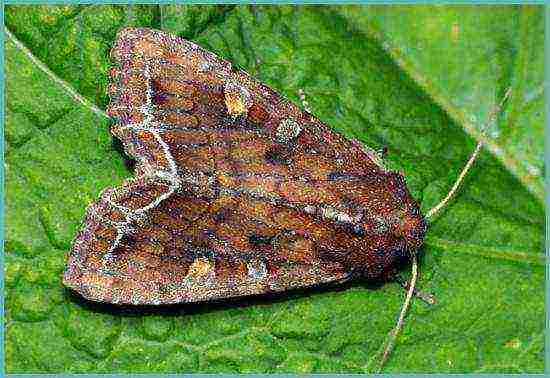
Tigridia pest - cabbage scoop
Of the diseases, tigridia can be susceptible to rot, scab and rust. Sometimes he gets sick with the mosaic virus. To prevent diseases, the bulb is soaked in fungicides before drying, and the leaves are periodically sprayed with antifungal agents or herbal infusions.
Tigridia: combination with other plants
As partners of tigridia, you need to select plants with similar requirements. For example, Indian cannes and blue onions will go together with tigridia as well as crested eukomis, daylily, dicentra or tuberous commeline. Letniki such as katananche, gypsophila, seaside lobularia and Drummond's phlox will also be good neighbors.
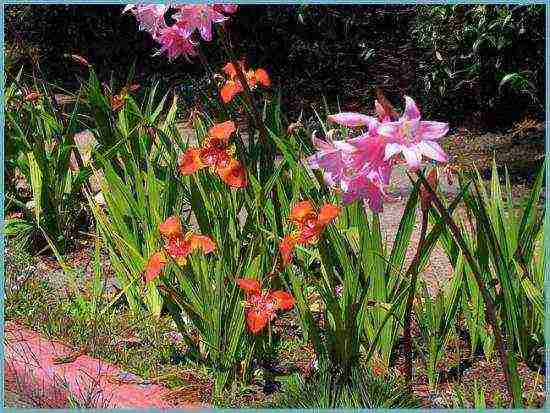
Tigridia in combination with a daylily in a flower bed
Tigridia in landscape design
In landscape design, tigridia are often used in group plantings. It is believed that the prettiest flower beds are obtained by planting different varieties of tigridia in one place. Thus, a variegated flower bed is obtained, pleasing the eye with a variety of colors. These flower beds are always spectacular if you are careful. The main thing here is not to overdo it with variegation. It is not recommended to plant other variegated flowers next to tigridia.
Bright tigridia look great in landscaping against a green background created with the help of a lawn and low plants such as sedum and thyme. Ornamental shrubs and green conifers will be an excellent background. Landings on the shore of a reservoir or near a large stone are interesting.
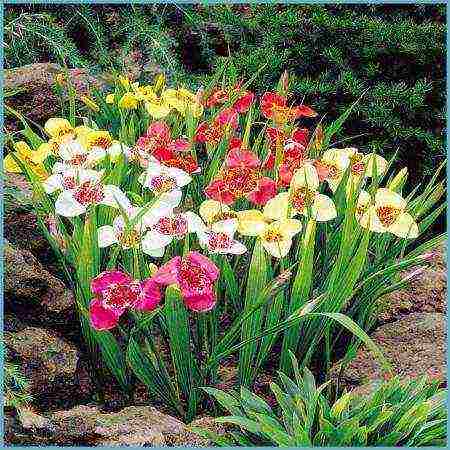
Group planting of tigridia
The advantage of tigridia is that they can be grown not only outdoors, but also in tubs and pots on the windowsill.
Blue-violet lobelias and heliotrope, as well as white and blue nirembergia will become spectacular neighbors in the tub.
If you want to add bright colors to your flower garden, then growing tigridia will fulfill this task one hundred percent. After all, tigridia, planting and caring for which even a novice florist can do, will provide you with magnificent flowering throughout the summer.And the ease of growing and reproducing will allow you to plant it over and over from year to year. This flower, reminiscent of a giant bizarre butterfly, will not leave anyone indifferent.
Bulb flower care: video
Varieties of tigridia: photo


